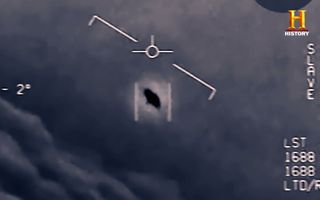UFOs Are Real, But Don't Assume They're Alien Spaceships
Aliens shouldn't be the default explanation for weird stuff in the sky.

UFOs are very real, as we have recently seen — but that doesn't mean E.T. has been violating our airspace.
"UFO" refers to any flying object an observer cannot readily identify. And pilots with the U.S. Navy saw fast-moving UFOs repeatedly off the East Coast throughout 2014 and 2015, in one case apparently nearly colliding with one of the mysterious objects, The New York Times reported earlier this week.
Those incidents were reported to the Pentagon's Advanced Aerospace Threat Identification Program (AATIP), whose existence the Times and Politico revealed in December 2017. (Interestingly, those 2017 stories cited Pentagon officials as saying that AATIP had been shut down in 2012.)
Related: 7 Things Most Often Mistaken for UFOs
Former AATIP head Luis Elizondo, by the way, is involved with a new six-part series called "Unidentified: Inside America's UFO Investigation," which premieres tonight (May 31) on The History Channel.
The Navy pilots said some UFOs reached hypersonic speeds without any detectable exhaust plumes, suggesting the possible involvement of super-advanced propulsion technology. Still, Defense Department officials aren't invoking intelligent aliens as an explanation, according to this week's Times story — and they're right to be measured in this respect, scientists say.
There are multiple possible prosaic explanations for the Navy pilots' observations, said Seth Shostak, a senior astronomer at the SETI (Search for Extraterrestrial Intelligence) Institute in Mountain View, California.
He pointed out, for example, that the sightings occurred off the coast, as did a similar 2004 observation unveiled in conjunction with the December 2017 stories. (That previous sighting occurred near San Diego).
Coastal regions are where you might expect to find a rival nation's advanced reconnaissance craft, Shostak said, because incursions over the continental United States would be more obvious and easily detected.
He also noted that, according to the recent Times story, the Navy pilots began spotting the UFOs after their jets' radar system was upgraded. That detail suggests the sightings might stem from some sort of software bug or instrument issue, he said.
"As anybody who uses Microsoft products knows, whenever you upgrade any technical product, there are always problems," Shostak said.
Such reasoning is bolstered by the current tendency of UFOs to manifest as blobs or blurs on the displays of advanced instruments rather than as crisply defined objects in cellphone photos.
"The sightings always recede to the edge of what technology allows you to do," Shostak said. "The aliens are kind of keeping pace with technology."
Common sense also argues against jumping to the E.T. conclusion. If these UFOs are indeed alien spacecraft, what exactly are they doing? Why were they sent here, across the vast gulfs of space and time?
"If the aliens are here, you gotta say they're the best houseguests ever, because they never do anything," Shostak said. "They just buzz around. They don't address climate change; they don't steal our molybdenum."
Related: UFO Watch: 8 Times the Government Looked for Flying Saucers
But such skepticism should not be taken as a dismissal of the E.T. possibility, Shostak stressed.
"It's not trivial to say what these things are," he said. And Shostak applauded a newly enacted classified Navy policy, as reported by the Times, instructing pilots on how to report UFOs (which the military, and many other people, now call "unexplained aerial phenomena," likely in an attempt to dodge the tinfoil-hat stigma associated with the term "UFO.")
"That's a good policy," he said. "Let them do it."
After all, we've learned over the past decade or so that our Milky Way galaxy is home to huge numbers of potentially habitable worlds. Observations by NASA's Kepler space telescope, for example, suggest that at least 20% percent of the galaxy's 200 billion or so stars likely harbor a rocky planet in the "habitable zone," that just-right range of distances where liquid surface water could exist.
So, while the odds may be long that any UFO witnessed to date was an extraterrestrial craft, it's far from crazy to suspect that intelligent aliens are out there somewhere (or at least were out there somewhere, at some point during the Milky Way's 13-billion-year history). That's why people like Shostak keep listening for signals from the sky.
- Why Is the Pentagon Interested in UFOs?
- 5 Bold Claims of Alien Life
- 10 Exoplanets That Could Host Alien Life
Mike Wall's book about the search for alien life, "Out There" (Grand Central Publishing, 2018; illustrated by Karl Tate), is out now. Follow him on Twitter @michaeldwall. Follow us on Twitter @Spacedotcom or Facebook.
Join our Space Forums to keep talking space on the latest missions, night sky and more! And if you have a news tip, correction or comment, let us know at: community@space.com.
Get the Space.com Newsletter
Breaking space news, the latest updates on rocket launches, skywatching events and more!

Michael Wall is a Senior Space Writer with Space.com and joined the team in 2010. He primarily covers exoplanets, spaceflight and military space, but has been known to dabble in the space art beat. His book about the search for alien life, "Out There," was published on Nov. 13, 2018. Before becoming a science writer, Michael worked as a herpetologist and wildlife biologist. He has a Ph.D. in evolutionary biology from the University of Sydney, Australia, a bachelor's degree from the University of Arizona, and a graduate certificate in science writing from the University of California, Santa Cruz. To find out what his latest project is, you can follow Michael on Twitter.
